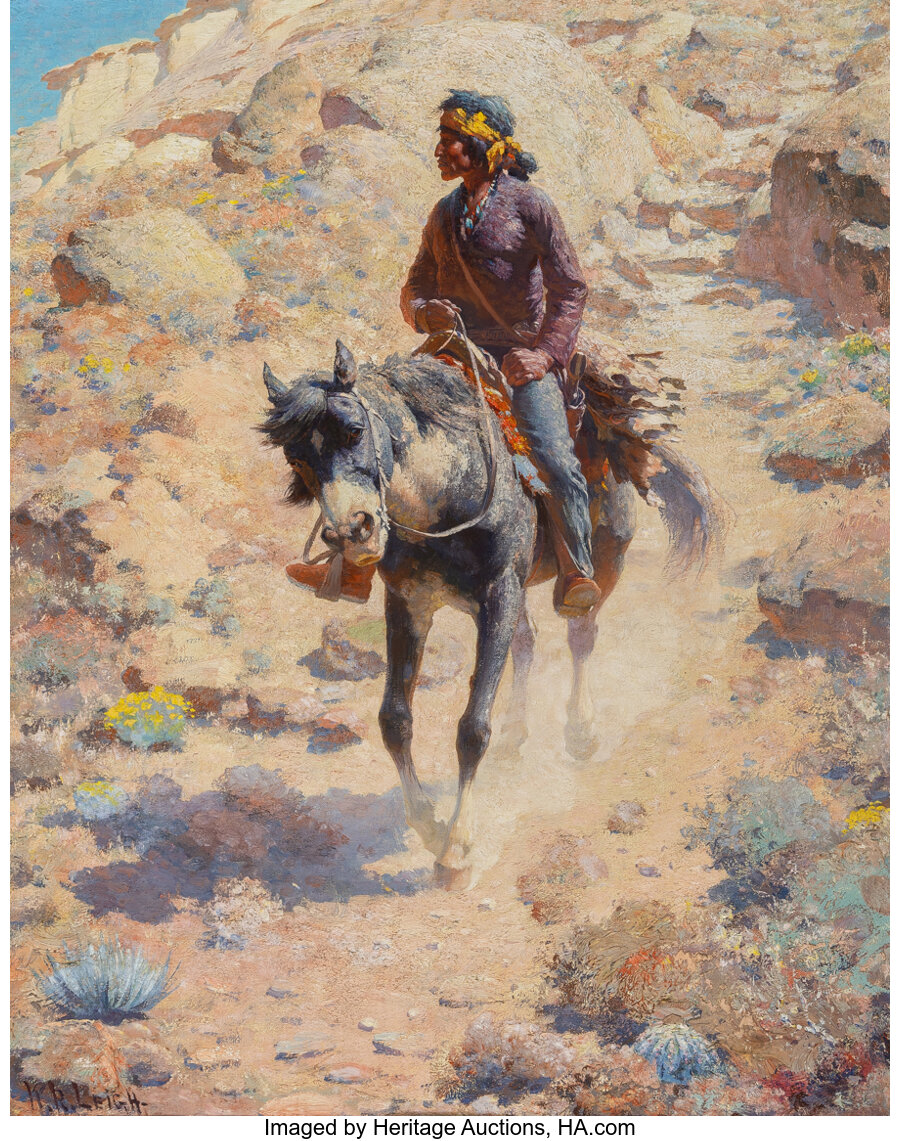William Robinson Leigh (American, 1866-1955) Navajo Trader Oil on canvas 28 x 22 inches (71.1 x 55.9 cm) Signed lower left: W.R. Leigh PROVENANCE: Robert Merryman, acquired possibly from artist; By descent to the present owner from the above. William Robinson Leigh was born in 1866 and grew up in rural West Virginia where he showed a very early aptitude for art. Born into a family that had lost their fortune in the Civil War, Leigh was able to attend the Maryland Institute in Baltimore at the age of fourteen through the generosity of his aunt and uncle. He excelled at the institute and left to study at the Royal Academy in Munich where he was steeped in the techniques of academic painting. Upon returning to the United States, Leigh struggled to find his artistic voice, working in illustration and historical subjects. While he had long dreamed of venturing into the American West to stoke his artistic imagination, the necessity of earning a living led to his decade-long work as an illustrator for the leading publications of the day, such as Collier's and Scribner's. Like his contemporary Frederic Remington, Leigh was frustrated by the constraints and lack of creativity in terms of subject matter and style that were necessary for the illustration market. His artistic breakthrough came when he entered into a mutually beneficial arrangement with the Santa Fe Railroad and traveled to the Southwest in 1906. There, he encountered a world vastly different from the Eastern cities or European art circles—a world of open plains, dramatic canyons, and Indigenous communities with deep cultural histories. Leigh agreed to paint images of the Grand Canyon and other Western subjects for use in the Railroad's advertising campaigns. During the next several years, Leigh traveled extensively in the Southwest and throughout the West, including the Yellowstone territory of Wyoming and Montana. At each location, he spent as much time as possible painting outside, often under the shade of a large umbrella. Navajo Trader exemplifies Leigh's fascination with the disappearing cultures and landscapes of the American West. With a cinematic quality that engages the viewer in stories of adventure, hardship, and heroism, this masterful depiction of a Navajo rider on horseback navigating a sun-drenched, rocky terrain was an image that encapsulated his deep investment in portraying the American West with both realism and romanticism. Leigh's academic background is evident in the structural clarity of the composition which guides the viewer's eye from the dusty trail that winds through sunlit rocks and low desert flora—yucca, sagebrush, and clusters of wildflowers upward to the sunlit rock formations in the backdrop. Leigh's use of light and shadow here is particularly masterful: the bright, almost bleached light of midday washes over the scene, flattening the shadows but creating a vibrant sense of place. The colors are earthy and rich, from the reds and ochres of the rocks to the pale greens and bright yellows of the desert foliage. This vivid palette not only brings the environment to life but also elevates the entire scene with a romantic, almost mythic quality. There's a strong verticality to the painting that enhances the sense of scale and the ruggedness of the terrain. The tight cropping and singular focus on the rider unified with his steed creates an intimate, narrative moment, frozen in time. The horse mid-step, kicks up dust that swirls around its hooves—a testament to Leigh's ability to capture movement and atmosphere. The rider's expression is one of quiet vigilance, and his posture suggests both physical fatigue and stoic determination. He wears a deep maroon shirt and a yellow headband, accented with turquoise jewelry, emphasizing his cultural identity. These details, rendered with great care, reflect Leigh's commitment to accurate and respectful representations of Indigenous peoples, in contrast to many of his contemporaries who relied on stereotypes. His skill in rendering figures and landscapes with equal care lent his paintings an authenticity that was both aesthetic and documentary. In the American Art arena, W.R. Leigh occupies a unique space as a painter who brought Old World techniques to New World subjects. Not only does Leigh bring a classical precision and narrative sensibility to a uniquely American subject matter--the rugged landscapes, Indigenous cultures, and frontier life of the late 19th and early 20th centuries--his work bridges the romantic idealism of Western expansion with a visual realism that places him among the foremost artists of his era in this genre. His depictions of Western life, characterized by dramatic compositions, vibrant use of color, and acute attention to detail, convey the spirit of endurance and dignity Leigh saw in its people. His work helped shape popular and artistic perceptions of the West during a period of rapid cultural transformation. Navajo Trader makes its debut on the market after over 100 years of remaining in the same family since its purchase. Through its technical brilliance and emotional depth, it stands as a quintessential piece in the canon of Western American art, and a testament to W.R. Leigh's legacy as one of its most accomplished visual storytellers. Through his brush, the American West becomes both legend and lived experience—an enduring tableau of cultural encounter and environmental grandeur. HID12401132022 © 2024 Heritage Auctions | All Rights Reserved www.HA.com/TexasAuctioneerLicenseNotice



